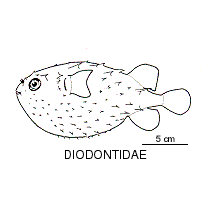- Classification
- ACTINOPTERYGII
- TETRAODONTIFORMES
- DIODONTIDAE
-
Fish Classification
-
Class
ACTINOPTERYGII Ray-finned fishes -
Order
TETRAODONTIFORMES Puffer-fishes -
Family
DIODONTIDAE Porcupinefishes
Family DIODONTIDAE
Small to medium-sized robust fishes, similar to pufferfishes, with bodies covered in large strong spines. Porcupinefishes have small mouths with teeth fused into a single beak-like unit in each jaw, slit-like gill openings and small dorsal and anal fins far back on the body. No other family has the following combination of characters: large spines on body; no pelvic fins; body inflatable.
Although they are slow swimmers, they can inflate their bodies into spiny spheres when alarmed, making it difficult for predators to attack.
They should not be eaten as the poison tetrodotoxin is found in their internal organs.
More Info
|
Family Taxonomy |
Seven genera and 19 species are recognised worldwide, with all genera and 12 species known from Australian waters. |
|
Family Distribution |
A small family found worldwide, mostly in shallow tropical seas.
Many porcupine fishes are nocturnal and usually shelter in caves, crevices and
under ledges during the day. |
|
Family Feeding |
Porcupine fishes are carnivores and use their powerful jaws and fused tooth plates to crush crabs, molluscs and sea urchins. |
|
Author |
Dianne J. Bray |
References
Brainerd, E.L. 1994. Pufferfish inflation: functional morphology of postcranial structures in Diodon holocanthus (Tetraodontiformes). Journal of Morphology 220: 243-261.
Gomon, M.F. 1994. Family Diodontidae. pp. 913-915, figs 805-806 in Gomon, M.F., Glover, C.J.M. & Kuiter, R.H (eds). The Fishes of Australia's South Coast. Adelaide : State Printer 992 pp. 810 figs
Gomon, M.F. 2008. Family Diodontidae. pp. 857-858 in Gomon. M.F., Bray, D.J. & Kuiter, R.H (eds). Fishes of Australia's Southern Coast. Sydney : Reed New Holland 928 pp.
Leis, J.M. 1978. Systematics and zoogeography of the porcupinefishes (Diodon, Diodontidae, Tetraodontiformes), with comments on egg and larval development. Fishery Bulletin (U.S.) 76(3): 535-567 figs 1-28
Leis, J.M. 1986. Family No. 269: Diodontidae. pp. 903-907 in Smith, M.M. & Heemstra, P.C. (eds). Smith's Sea Fishes. Johannesburg : Macmillan South Africa xx + 1047 pp. 144 pls
Leis, J.M. 2001. Diodontidae. pp. 3958-3965 in Carpenter, K.E. & Niem, T.H. (eds). The Living Marine Resources of the Western Central Pacific. FAO Species Identification Guide for Fisheries Purposes. Rome : FAO Vol. 6 pp. 3381-4218
Matsuura, K. 2014. Taxonomy and systematics of tetraodontiform fishes: a review focusing primarily on progress in the period 1980 to 2014. Review for IPFC9 Special Issue. Ichthyological Research 62(1): 72-113. Open access DOI:10.1007/s10228-014-0444-5
Summers, A. & Bensusen, S.J. 2001. A Fish Story. The spiny puffer's means of defense is hard to swallow. Natural History Magazine. American Museum of Natural History. October: 86-87.
Tyler, J.C. 1980. Osteology, phylogeny, and higher classification of the fishes of the order Plectognathi (Tetraodontiformes). National Marine Fisheries Service (U.S.). Technical Report 434: 1-422 figs 1-326
Winterbottom, R. 1974. The familial phylogeny of the Tetraodontiformes (Acanthopterygii : Pisces) as evidenced by their comparative myology. Smithsonian Contributions to Zoology 155: 1-102 figs 1-185


























































































